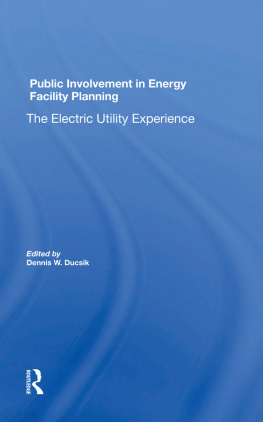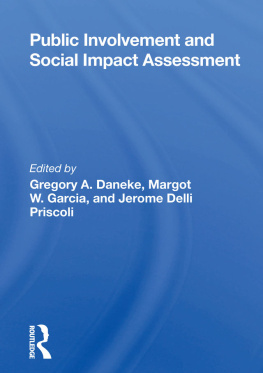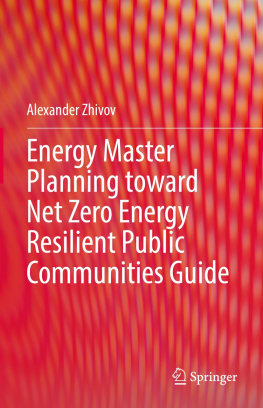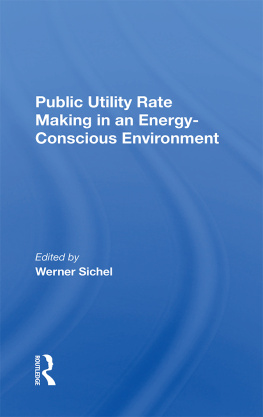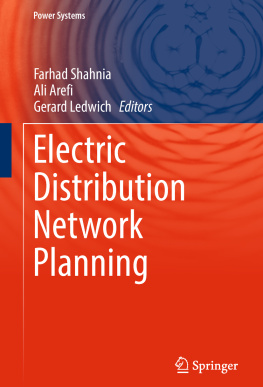Dennis W Ducsik - Public Involvement in Energy Facility Planning: The Electric Utility Experience
Here you can read online Dennis W Ducsik - Public Involvement in Energy Facility Planning: The Electric Utility Experience full text of the book (entire story) in english for free. Download pdf and epub, get meaning, cover and reviews about this ebook. year: 2019, publisher: Routledge, genre: Politics. Description of the work, (preface) as well as reviews are available. Best literature library LitArk.com created for fans of good reading and offers a wide selection of genres:
Romance novel
Science fiction
Adventure
Detective
Science
History
Home and family
Prose
Art
Politics
Computer
Non-fiction
Religion
Business
Children
Humor
Choose a favorite category and find really read worthwhile books. Enjoy immersion in the world of imagination, feel the emotions of the characters or learn something new for yourself, make an fascinating discovery.
- Book:Public Involvement in Energy Facility Planning: The Electric Utility Experience
- Author:
- Publisher:Routledge
- Genre:
- Year:2019
- Rating:4 / 5
- Favourites:Add to favourites
- Your mark:
- 80
- 1
- 2
- 3
- 4
- 5
Public Involvement in Energy Facility Planning: The Electric Utility Experience: summary, description and annotation
We offer to read an annotation, description, summary or preface (depends on what the author of the book "Public Involvement in Energy Facility Planning: The Electric Utility Experience" wrote himself). If you haven't found the necessary information about the book — write in the comments, we will try to find it.
Dennis W Ducsik: author's other books
Who wrote Public Involvement in Energy Facility Planning: The Electric Utility Experience? Find out the surname, the name of the author of the book and a list of all author's works by series.
Public Involvement in Energy Facility Planning: The Electric Utility Experience — read online for free the complete book (whole text) full work
Below is the text of the book, divided by pages. System saving the place of the last page read, allows you to conveniently read the book "Public Involvement in Energy Facility Planning: The Electric Utility Experience" online for free, without having to search again every time where you left off. Put a bookmark, and you can go to the page where you finished reading at any time.
Font size:
Interval:
Bookmark:

52 Vanderbilt Avenue, New York, NY 10017
2 Park Square, Milton Park, Abingdon, Oxon OX14 4RN
Product or corporate names may be trademarks or registered trademarks, and are used only for identification and explanation without intent to infringe.
Public involvement in energy facility planning.
(Westview special studies in natural resources and
energy management)
"Annotated bibliography on citizen participation
in power facility siting": p.
1. Public utilities--Location--Decision making--Citizen
participation. I. Ducsik, Dennis W., 1946
II. Series.
HD9685.A2P83 1986 363.6'2'068 86-1620
- PART ONE
ISSUES AND CONCERNS - PART TWO
VIEWS OF PARTICIPATION PRACTITIONERS - PART THREE
SELECTED PUBLIC INVOLVEMENT PROGRAMS - PART FOUR
DETAILED CASE STUDIES
- PART ONE
ISSUES AND CONCERNS - PART TWO
VIEWS OF PARTICIPATION PRACTITIONERS - PART THREE
SELECTED PUBLIC INVOLVEMENT PROGRAMS - PART FOUR
DETAILED CASE STUDIES
- ii
- iii
Font size:
Interval:
Bookmark:
Similar books «Public Involvement in Energy Facility Planning: The Electric Utility Experience»
Look at similar books to Public Involvement in Energy Facility Planning: The Electric Utility Experience. We have selected literature similar in name and meaning in the hope of providing readers with more options to find new, interesting, not yet read works.
Discussion, reviews of the book Public Involvement in Energy Facility Planning: The Electric Utility Experience and just readers' own opinions. Leave your comments, write what you think about the work, its meaning or the main characters. Specify what exactly you liked and what you didn't like, and why you think so.

